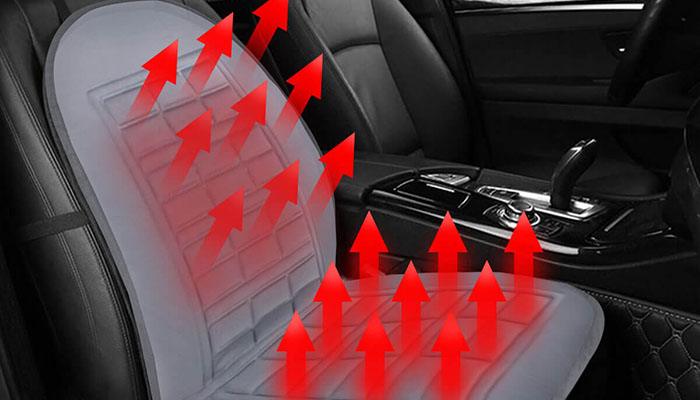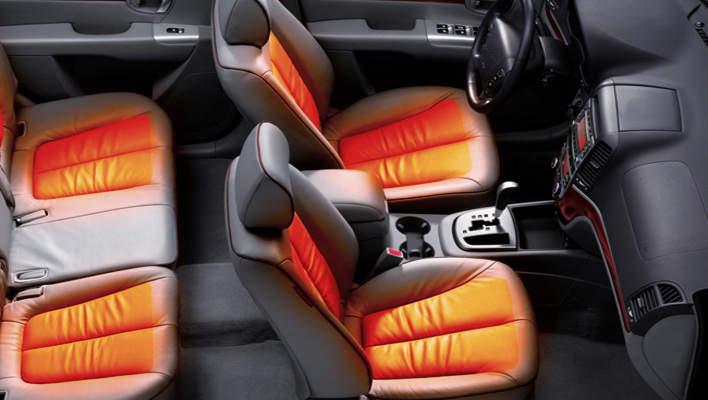How do heated seats work? Are they safe?
A heated blanket or sofa keeps us warm and active when we are in our house. How to keep yourself warm while driving? The answer is a heated car seat.
A heated car seat is powered by a heating element that works like a resistor. When we turn on the power, it converts energy into heat. As a result, the car seat remains warm and comfortable for you.
How do heated seats work?
The heating element in heated seats is a long strip of material that acts as a resistor. In an electrical circuit, a resistor resists current flow. It converts the energy flowing through it into heat, which circulates through the seat. As a result, it warms the rider.
Turning on a heated seat
A relay controls the heated seats. With it, a small power produces a much bigger effect. A small current flows through the coil in the relay when you turn on the switch by flipping it.
An open switch is located near this coil. In current-driven coils, a magnetic field is created as current flows through them. As a result, the seat cushion heating element receives electricity from the battery. When you turn on the seat heater in some cars, you can hear a click as the relay closes.
You can change the heat settings too (high, mid, and low).
Here is how a heated jacket work.
What happens when a heated seat is kept on for a longer time?
When the seat cushion is left on for a long time, it gets hotter. Leaving it on too long would result in it becoming too hot to sit in. Further, the cushion may even catch fire.
A thermostat prevents this from happening. The thermostat measures the temperature in the cushion. The thermostat sends a signal when it reaches a certain temperature, shutting down the relay until the seat cools down. Once the car seat cools down, the thermostat starts the relay again.
Are heated eyelash curlers safe?
Does a heated car seat drain the battery?
Yes, it drains the car battery. The amount and extent vary according to the battery, coil design, and charging system condition.
How to install heated car seats?
Heated seats can be installed in almost any vehicle. The kits are straightforward to install, and the installation costs are affordable. Dealerships also install seat heaters for a reasonable fee if you live in a cold climate.

The mechanism of a heated seat is similar to heated jackets, blankets, socks, and gloves.
DIY heated car seat installation
Taking off the seat cover
Seats and backrests are the two standard parts of a car seat. For the heating elements to be put together, the covers of both parts must be taken off. If the upholstery isn’t glued, this is only possible. A garage would be needed to take off the covers and then put them back together the way they were.
All other models have removable fabric or leather covers. Once you have removed the central filling from the seats, you can see where the heating mats lay.
Seat heating installation and wiring
Manufacturers make seat heating elements for a variety of seat sizes. It might be necessary to cut them to size. If the heating elements are seated exactly along the seating seam, then the marking of the cutting must be precise. During cutting, be sure not to cut through the side strips since they act as the poles for the seat heating.
Many manufacturers also provide two-sided tape for the application of heating mats. Insulation tape must first be placed on the seating seam before it is glued. Seating seams should be shortened whenever the rod is in place to make no contact with the poles.
Moreover, an additional layer of insulation is needed if shortening cannot be achieved. This is how a heated seat works.
Testing
Backrest heating elements are usually connected to seat heating mats. The battery supplies electricity at a rate of 5 to 10 amps. Direct and relay connections are available depending on the model. Furthermore, heating elements also come with a matching electric diagram.
The wiring and corresponding switches in the dashboard are technically more complex. The cables of the heating cushions are concealed. For a neat, concealed connection, the supplied cable may need to be extended.
If you’ve connected the seat heater correctly, you can test it. To generate a heating effect, you must be seated in the seat during the test period. A running engine is the only way to experience full performance. Check the electronics and seat warming by taking a short drive.
Benefits of a warming seat
The following are the benefits of heated seats:
- Heated seats provide warmth, which is the most obvious benefit.
- Those with chronic lower back pain may also find heated seats helpful. Since heat is known for relieving muscle pain, heated car seats would be a great solution.
- It allows you to warm up faster because it is near your body. A heated seat in your car is an excellent way to warm up if you’re on the go and need to warm up fast.
Aare heated seats dangerous?
Heated seats aren’t dangerous at all. However, when your body adapts to remaining in contact with heat for hours, it can result in erythema ab igne. There may be a rash as well as mild burning or itching in this condition.
Are heated seats worth it?
The worth of heated seats depends on where your location. It’s worth it if you have prolonged periods of freezing weather in your area.
We discussed how heated seats work, DIY installation, and their benefits. If you plan to buy a heated seat, don’t forget to check the material, warranty, and ease of installation. The material should be breathable (allowing enough ventilation). If it snows a lot in your area, you can also read how a heated driveway works.
Additional Questions
Are heated car seats safe?
While heated car seats are generally safe and can provide a much-needed comfort during those cold winter months, there are potential issues to be aware of. Primarily, if you’re frequently using them for extended periods of time or if your seat heating function malfunctions, there’s a possibility of causing skin irritations such as rashes, lesions, and at worst, burns. This isn’t to say that using heated seats is inherently bad, but moderation and careful usage are advised. Most importantly, leaving the seat heater on excessively might potentially lead to a fire situation. As a rule, if the seat starts feeling uncomfortably hot, it’s probably best to turn it down or off, just as you would do with a heating pad or electric blanket.
Does heat damage car seats?
The impact of heat on car seats really depends on factors such as the car’s interior environment and the material of the seats. Heat can affect both fabric and leather car seats, causing them to dry out and eventually crack. This is more poignant in scenarios where your vehicle is parked in a sunny location, resulting in a heat buildup inside. Regardless of whether the vehicle is in direct sunlight or not, any environment causing an increase in your car’s interior temperature can accelerate the process of your car seat’s material drying out. So, it’s advisable to try to park your vehicle in shaded areas where possible, or use sun shades to protect your seats and overall interior from direct sunlight.
Do heated seats damage leather?
A lot of us who own vehicles with leather seats might have wondered at some point whether or not using heated seats could ruin the leather? The good news is that leather upholstery in cars is typically designed to hold up quite well against heat from seat heaters. However, extensive use of heated seats can lead to your leather seats slowly losing their moisture, potentially leading them to dry out. This is generally more of a slow process rather than an immediate impact, but can be prevented or prolonged by regularly conditioning your leather seats. It’s quite similar to applying lotion to your skin to prevent or heal dryness.
What temperature do heated seats work?
The usage of heated seats is usually dependent on the outside temperature and varies by the vehicle model and its settings. In many vehicles, the heated seats and steering wheels (if the car has this feature) will automatically turn on when the car engine starts and the outside temperature is 40° F or below. Similarly, for vehicles equipped with ventilated seats, these are set to start cooling when the weather is 80° F or hotter. This feature kicks in upon starting the car’s engine either manually or remotely. However, most vehicles also offer manual controls for these features, so you have the freedom to customize your comfort.

Annika Ramos is a physiotherapist with a passion for helping people recover from injuries and illnesses. In her spare time, she enjoys exploring her creative side through various craft projects.

